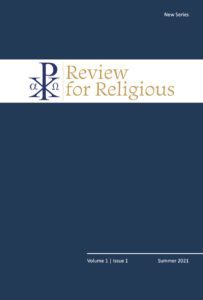We invite you to preview Review for Religious 2, no. 3 (Fall 2022)!
Review for Religious 2:3 is out! This is our special issue on “religious life at the peripheries,” featuring articles on:
- the possibility of a new ministry for religious that focuses on accompaniment of survivors of abuse;
- religious life as a life of penance and the habit as a penitential garment;
- the psychological dynamics of identity, agency, belonging, and purpose.
Other articles are included, as well – get to know the latest the issue by downloading the table of contents, reading the sample article, or previewing excerpts from all the articles below.
Excerpts From the Fall 2022 Issue
The past decade has not been a happy one for the Catholic Church in France. It has seen the resignation of a number of its bishops, including the archbishops of Paris, Lyon and Strasbourg and the closure of a number of French-founded religious communities and ecclesial movements. Most of these evolved as part of the new springtime of the Church in France that saw new communities, largely of Charismatic origin, emerging from what some French Catholics experienced as the ruin of traditional faith by the Second Vatican Council. As seminaries and novitiates stood empty, the formation houses of these communities progressively filled with young people in search of a dignified and engaging style of liturgy and prayer and a sense of intense commitment which connected them strongly to the spiritual traditions of a country in which the mystical and religious life have flourished down the centuries
It is quite hazardous to discuss the religious habit. For many American Catholics, religious clothing symbolizes the intra-ecclesial squabbles of the past half-century. To over-emphasize the habit is to risk obscuring the clear teaching of the Church that the habit is a secondary aspect of religious life, merely a support in living the essence of the religious life—the evangelical counsels. To under-emphasize the habit, however, is to risk denigrating physical, sacramental signs, and to reject the magisterium’s continued insistence on the value of the habit.
With the approach of the new millennium, the scene changed radically. Religious in the United States and elsewhere were immersed in issues of aging and diminishing numbers of new members. Leadership was challenged to find new ways of sustaining existing ministries. Some compared the response to triage. Others saw an opportunity for new ways of fostering the charism. Collaboration with lay associates and the establishing of sponsorship councils and boards of trustees offered avenues of continuity and ushered in innovative roles and means of assuring mission integrity and faithfulness to the charism.
What has been weak or absent in many existing initiatives is a clear focus on a theology of healing for the millions of our brothers and sisters and their families, as victim-survivors, who continue to suffer, many silently. In this ministry, we need to provide opportunities for our wounded brothers and sisters to share their experiences of pain and suffering, to support them in their journeys of hope and healing, and even empower them to become a Christian community of ministers of mercy and compassion—wounded healers for others. St. Paul recalls the very words of Jesus “My grace is sufficient for you, for power is made perfect in weakness” and “… for the sake of Christ; for when I am weak, then I am strong” (2 Cor. 12:9-10).
When it comes to religious ministry with people who find themselves on the peripheries, the question is often asked how religious are serving said people. Yet, this question obscures the most important dimension of the relationship between religious and the peripheries. Religious ministry on the peripheries is not primarily about what service religious have to offer, whether it be medical, educational, catechetical, or otherwise.
